#microbot
Explore tagged Tumblr posts
Text

Your desktop companion, fully controllable from your synced smartphone.
9 notes
·
View notes
Text
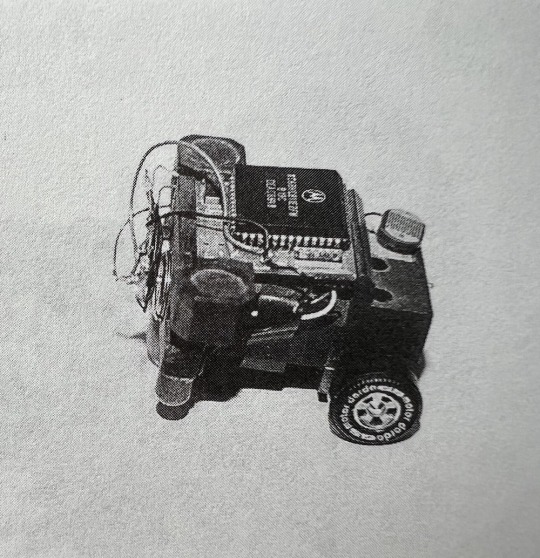

Squirt (1987) by Anita Flynn and Rodney Brooks, MIT AI Lab, Cambridge, MA. Squirt is said to be “The World's Largest One Cubic Inch Robot”, incorporating an 8-bit computer, an on-board power supply, three sensors and a propulsion system in a tiny package a tad over 1 cubic inch in volume. It hides in dark comers, venturing out in the direction of noises, but only after the noises are long gone, looking for a new place to hide. “We have noticed from engineering all our previous robots that the bulk of most robots is made up of motors and batteries, whereas the components wherein we focus our research, the sensors and computers, take up only a small amount of space. We built Squirt as an exercise in shrinking brawn down to the scale of the brain using strictly off the shelf components. The design goal was a final volume of one cubic inch, but Squirt came in a little over spec, about 1 1/4 cubic inches, hence the accolade.” – Fast, Cheap and Out of Control: A Robot Invasion of the Solar System by Rodney Brooks and Anita Flynn.
47 notes
·
View notes
Text
The Microbot Mallet might be the coolest pickaxe in the entire game, even if it's only for its contrail.
3 notes
·
View notes
Text

Kelly Macdonald and Faye Marsay in Black Mirror (2011) Hated in the Nation
S3E6
In near-future London, police detective Karin Parke and her tech-savvy sidekick Blue investigate a string of mysterious deaths with a sinister link to social media.
*When deciding the order in which the third season would air, Charlie Brooker was explicitly told by Netflix that this episode could not be the season premiere because its extended length would discourage viewers from watching the next episode right away.
#Black Mirror#2011#tv series#Hated in the Nation#S3E6#Kelly Macdonald#Faye Marsay#near future London#tech-savvy sidekick#London#murders#micro drone#microbot#pollination robot#bee robot#technology#social media#hatred#drone attack#mastermind#killer drone#hashtag#social behaviour#crime#drama#mystery#thriller#scifi#just watched#2016 episode
1 note
·
View note
Text

Coronavirus microbot
Midjourney prompt: **highly detailed schematic of a coronavirus drone designed to mimic the anatomy of a coronavirus, presented in the style of an encyclopedia page or a detailed textbook illustration. This page, various annotations and labels in English, detailing each part, head --style raw --p k4sbz7n** - Image #2
#Midjourney#coronavirus#microbot#AI#AI art#AI art generation#AI artwork#AI generated#AI image#computer art#computer generated
0 notes
Text

1 note
·
View note
Text

NIBBLE, the microbot bug (dic.2023)
#artists on tumblr#art#my art#digital art#oc art#my ocs#original character#character design#nibble#microbot#robot#insect#bug
0 notes
Text



Bumblebee will fight anyone for his friends. Even his friends
112 notes
·
View notes
Text
We should talk about microbots
Cybertronians that are so small they're oft forgotten about, the tallest comes in at barely 5 inches in a world where everyone is between 10 and 50 feet high
They're regularly poisoned by doctors because dosages are off. They can't get housing or access most buildings because it's all too big for them. Public transport is a death trap. They can't use the roads and are forced to hitch hike. Most mecha have never even seen a microbot before, or don't know that they have, because they're so small.
Please imagine the teeny tiniest bots no bigger than a human finger, living in discarded dollhouses and old boxes. Always having to run for their lives whenever one of the "Big Ones" walks past them lest they be trampled and stomped into paste. Tiny bots trying to get an education and having to walk along their textbooks, reading words row by row, having to jog back across the screen everytime they reach the end. Tiny bots trying to join decepticon protests because they would like better treatment, too, but no one can hear their little voices and they're nearly kaiju'd. Tiny bots struggling to find any form of housing that's accessible without an hour of climbing and huffing and puffing. Tiny bots that are stepped over and unnoticed and always lrft with the shortest end of the stick. Tiny bots drowning in rain puddles that may as wrll be small oceans, tiny bots that can't even go to the doctor when they're sick because they can't get into the building, and doctors aren't trained for them anyway so they're often poisoned by incorrect doees. Tiny bots that are caught in the crossfire when the war starts, unable to evacuate from battlegrounds as their tiny cobbled together homes are smashed and burned.
Just. Wittle microbots. I can't stop thinking about them. AU where some of our faves are tiny and struggling for equality. Maybe an AU where Megatron has never actually been seen at any of his protests, and they think his speeches are pre-recorded and he's staying out of public view. But no, he's actually a microbot that's just tired of being walked all over, and he's up there on the podium speaking into a megaphone generously provided by Soundwave 🥺 imagine Soundwave carrying teeeeeny tiiiiny Lord Megatron around, letting him command from the palm of his hand. Starscream's mutiny just involves putting him in a jar 🤭
26 notes
·
View notes
Text
An Abbreviated History of Mecha Part 2: AWAKEN! SUPER ROBOT!!! (1970-1979)

(Read in the voice of Tessho Genda) ITS NAME IS.... MAZINGER.... Z!!!!!!!!!
Welcome back to An Abbreviated History of Mecha. Last time, we covered the origins of mecha by highlighting some of the major works of the time including Godzilla and Ultraman, which are not really mecha but are just as influential to the genre as the other shows mentioned.
Today, we will be moving on to the 70's. Here we will see three extremely iconic entries to the canon make their grand entrances, known to Super Robot Wars fans as the Holy Trinity. We'll also see a lot of the classic mecha tropes become codified with a lot of these entries. So, let's MAZIIIN GO!
Kamen Rider (1971)

Kamen Rider is the second iconic series created by mangaka Shotaro Ishinomori and would be part of the reason why henshin heroes (that is, heroes who transform) would become so popular. More importantly, Kamen Rider would give us one of the most homaged attacks of all time: the Rider Kick! And in case you're wondering, yes, Ishinomori still has one more series worth mentioning.
Kamen Rider, alongside Godzilla and Ultraman, got a 2023 retelling in the form of Shin Kamen Rider, courtesy of Hideaki Anno.
Mazinger Z (1973)

Mazinger Z is one of the many iconic series created by legendary mangaka Go Nagai. If Tetsujin 28 was the original "super robot", Mazinger Z would be the series that would introduce a lot of the tropes now commonly associated with a lot of giant robot anime, including but not limited to:
A robot that has to be piloted from the inside
A chest blaster
Laser eyes
Hot-blooded pilots
The term "super robot"
And most important of all, the rocket punch
Let's just say that there's a good reason why Mazinger Z (and this is just Mazinger Z) is the first of the three pillars of the Holy Trinity. Mazinger also has, in terms of sequels and adaptations:
Great Mazinger
UFO Robot Grendizer
Mazinkaiser
Shin Mazinger Z/Mazinger Edition Z: The Impact
Mazinger Z Infinity
Getter Robo (1974)

Created by Ken Ishikawa with help from Go Nagai, Getter Robo would be the second pillar of the Holy Trinity alongside Mazinger Z. Getter Robo would be important for introducing concepts such as a robot piloted by multiple people and, more importantly, Getter Robo would also introduce us to the combining robot, which is why it requires multiple pilots to man.
Getter Robo would get multiple sequels and spinoffs including, but not limited to:
Getter Robo G
Getter Robo Go
Shin Getter Robo Armageddon!
Shin Getter Robo vs Getter Robo Go
New Getter Robo (not to be confused with Shin Getter Robo)
Getter Robo Devolution
Eventually Ken Ishikawa would pass away before he could wrap up the series with Getter Robo Arc. I will come back to Getter Robo at some point in this series though, but to give you a hint: the series does get a conclusion.
I think I'd also be mistaken not to link to Cheese GX's excellent video retrospective on Getter Robo.
Super Sentai (1975)
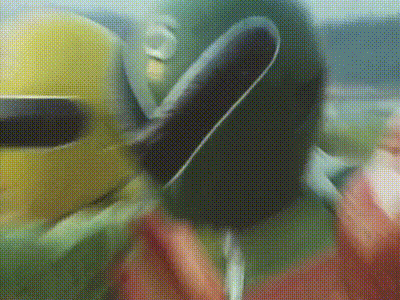
Because Shotaro Ishinomori wasn't content with creating two iconic series, he went ahead and made a third: Super Sentai. That's right: Ishinomori created the two most iconic versions of the henshin hero. Super Sentai is worth mentioning here due to the fact that the series would eventually start adding giant robots into the mix. This series would also eventually attract the attention of one Haim Saban, but that's a story for another day.
Microman/Microbots (1974)
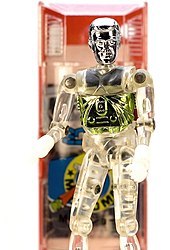
Microman (the toy, not the wrestler) was a line of, and I'm not joking when I say this, "Tiny Little Guys" released in 1975 by the toy company Takara. I'm not super familiar with Microman, but I feel it is important to mention Microman here to understand that one of the biggest names in mecha is descended from this line of toys, as it would start out as a spinoff of microman. Something about transforming vehicles the micromen could pilot. Who could know?
Also fun fact, there's a wrestler named Microman.
Brave Raideen (1975)

(We'll have to settle with this clip from Super Robot Wars)
Brave Raideen is a series created by Studio Sunrise and is one of the first giant robots that is considered to be supernatural in origin. Raideen is important in the history of mecha as it is where two important figures would come into play: Yoshiyuki Tomino and Tadao Nagahama. While it is largely overshadowed by other bigger series, Raideen is still important due to it being the first stepping stone for those two directors alone.
Space Battleship Yamato/Star Blazers (1975)

Up next is Leiji Matsumoto's legendary Space Battleship Yamato. This series would be one of those watershed moments in anime history as Yamato would prove that there was, in fact, an audience who wanted more serious war stories. To say that this series isn't that influential would be a mistake, as we will soon see.
Space Battleship Yamato would eventually receive multiple adaptations, including a live-action film and an anime reboot in the new millennium. The success of Yamato would also help pave the way for other Leiji Matsumoto works like Space Pirate Captain Harlock and the Galaxy Railway 999.
The Robot Romance Trilogy (1976-1979)

(Pictured above: Voltes V)
The Robot Romance Trilogy is a thematic trilogy created by Toei and directed by Tadao Nagahama. These series would include:
Super Electromagnetic Robot Combattler V (V as in the letter)
Super Electromagnetic Robot Voltes V (V as in the number)
Fighting General Daimos
The Robot Romance Trilogy is known for building off of the innovations of its peers. Whereas Getter Robo combined by smashing three jets together (and thus was hard to translate into a toy), Combattler V was designed in a way where the parts of the robots actually made sense when combining to form the robot. This also doesn't even touch on the fact this trilogy would also help to popularize things like the five man band (alongside Super Sentai), mecha shows having more serious storylines with melodrama, and funnily enough, the motion capture mecha (specifically Daimos).
Voltes V is also extremely popular in the Philippines. While this isn't unheard of at this time, Voltes V was different in that it was banned from airing on television by the Marcos regime. Speculation behind its ban may be that its themes were similar to the plight of the Filipino people under Marcos, so you could say that Voltes V in particular is a symbol of rebellion in the Philippines. Heck, it was so popular that there now exists a live action Voltes V series filmed in the Philippines.
Zambot 3 & Daitarn 3 (1977 & 1978)

(Pictured above: Zambot 3)
Meanwhile, Yoshiyuki Tomino would continue to push boundaries as he got more into the groove of directing. On top of producing Voltes V (according to Wikipedia), Tomino would work on a few more series before the end of this decade. The first two would help to establish a pattern with Tomino's works, where he would follow up a more serious and depressing series with something more lighthearted and silly. Zambot 3 would help Tomino earn his nickname "Kill 'Em All Tomino," while Daitarn 3 would also show that he knew how to relax when working on a series. Both Zambot 3 and Daitarn 3 were big hits, but the next series would forever cement Tomino as a legendary figure in the world of anime and manga.
Mobile Suit Gundam (1979)

Mobile Suit Gundam, the final pillar of the Holy Trinity, is arguably Yoshiyuki Tomino and Sunrise's single most important series date. Arguably the single most famous mecha of all time, Gundam would be the first giant robot to be treated less as a hero and more as a tool of war, and it would be Gundam who would kick off a new generation of mecha stories that focused more on things like war and how it affects the lives of the characters in these stories. Which is funny, because Gundam was initially a flop at first. Over time, the series would eventually become a hit thanks to its compilation movies as well as the sale of its models and, most important of all, its female fans.
Mobile Suit Gundam would also be a watershed moment in animation history, as it would be the introduction to a lot of people who would also become famous thanks in part to this series. This includes people who worked on the show like Yasuhiko Yoshikazu (the character designer), Kunio Okawara (mechanical designer, and arguably the first credited mechanical designer), and Ichiro Itano (animator, the same man who Itano Circus is named after). Gundam would also be a direct inspiration for one Ryousuke Takahashi, who would begin to really push the boundary for what one could do with military mecha shows.
Conclusion
I hope this was an enjoyable read. Next time, we'll be getting into the 80's, where we will begin to see a lot of series pop up as Japan's economy grows at an exponential rate. We'll also see how these giant machines will come to influence people outside of Japan on top of how they build off of the themes present in the first Gundam.
Will you survive?
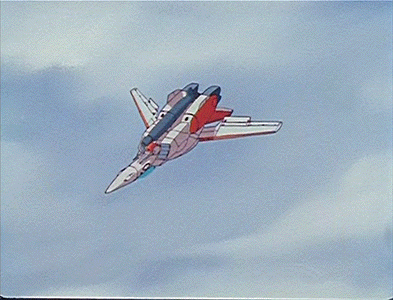
#anime and manga#mecha#an abbreviated history of mecha#mazinger z#getter robo#robot romance trilogy#combattler v#brave raideen#zambot 3#daitarn 3#voltes v#daimos#space battleship yamato#mobile suit gundam#kamen rider#super sentai#microbots#microman#the toy not the wrestler
22 notes
·
View notes
Note
WATT.. MY SHAYLAAA😭😭
i can imagine the tiny heeled footprints she leaves that bigger bots can try to look out for. she’s so professional -ckg
SHE’S YOUR SHAYLA???? 🥺🥺🥺😭😭 I’M HONORED TYSM
But OUUGH oh my god that’s so adorable 😭😭
And YES she is a professional!!! I wanted this revamp of her to be like a bit of an upgrade for her :D girly’s got a promotion and new responsibilities to be anxious about (on top of the existential crisis that comes with learning you’re actually Super Fucking Tiny </3),,, I tried to keep the girlfailure energy that I knew you liked hehe <3
#relic answers#OC: Watt#pls send me asks about her. pls#I wanna talk about her and the microbots more so bad#(/nf)
3 notes
·
View notes
Text
Please don’t unfollow me or stop interacting, but I don’t really watch the series nor do I like the artstyle… but I won’t be a dick if you like it 👍 (also Baymax art)
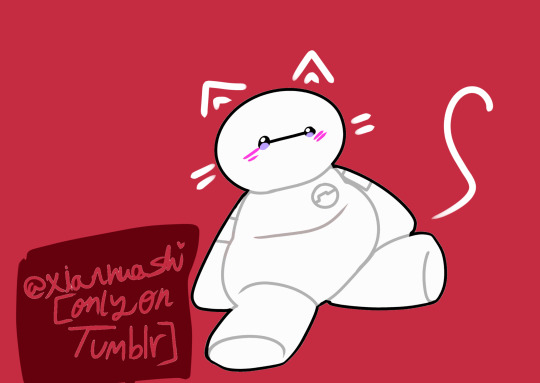
#big hero 6#baymax#tadashi hamada#hiro hamada#artists on tumblr#confession#please don’t be offended#im sorry#forgive me#I don’t like the baymax series either#baymax is cute though#but why do people simp over him?#I’m genuinely curious#please follow me#follow me#please#desperate#i want followers#hiro x gummybears#tadashi x the pizza during the microbots sequence#hot take#question mark#idk man#help me#happy lunar new year even though that was in February#damn#aaaand post#xianhua art
12 notes
·
View notes
Text

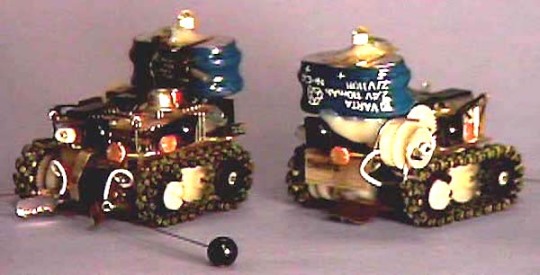





Ants: Anita, Sandra, Kisha, Tracie, Niqi, and Hope (1995) by James McLurkin, MIT AI Lab, Cambridge, MA. There were six robot ants, all with womens’ names since all worker ants are female. We see McLurkin with his ‘Ant Farm’, and before and after images of the ants foraging for ‘food’, then responding to signals from the first ant to find it. “The Ants are programmed with a subset of Brooks' Subsumption Architecture implemented in 6811 assembly language. A program for the Ants would consist of a group of behaviors, arranged in a hierarchy. … A behavior is a small piece of code that acts like a finite state machine. … This is an effective method of providing the robot with a response for every possible sensory input, without having to explicitly program for every condition. Summing the responses of many behaviors is a much easier task that looking at all of the sensory inputs and then trying to decide what to do. As a result, the robots can exhibit surprisingly complex actions with a very small amount of software. … When a robot finds food, she stops and transmits I-found-food through her IR beacon emitter. Other members in the vicinity that detect this signal head towards her, transmitting I-see-a-robot-with-food from their beacon emitters. Any robot that detects this secondary signal heads towards it until they receive the primary signal, then the head towards the first robot. In this manner, many robots can be vectored towards a large food source quickly.” – The Ants: A Community of Microrobots by James McLurkin.
43 notes
·
View notes
Text
so me and Sam FINALLY watched the last season of Capaldi's Who
and tell me how, after literally over a decade and for perhaps the first time in his fucking career, Steven Moffat wrote a not just tolerable but really actually good two-parter and fully stuck the landing. like the editing and pacing were still a bit off but the storyline was original, fun, interesting and emotionally invested, and most importantly, rather than ending on a damp fart or the most furious autofellatio in history, the final part didn't fumble it and ended in a way that felt emotionally satisfying and like it made sense for the characters. like the last time he successfully wrapped up a multiparter in a way that didn't feel cheap and hollowly disappointing to me was literally The Empty Child/The Doctor Dances, and a) that was in 2005 and b) tbh The Doctor Dances is about a tenth as compelling and memorable as The Empty Child.
so after 12 years of either hackery or great ideas that fall apart in the second act, Steven Moffat writes what I would genuinely consider to be a memorable Good Doctor Who serial. it ends with bittersweet pathos, a solid closer for all the main characters, and sends Moffat's showrunning career out on a genuine high despite failing ratings and budget cuts (and the fact Doctor Who hasn't been consistently good since about 2009). good job Steve. with grudging respect I admit you pulled it out of the bag on this one.
wait what's this there's one more episode left? and it stars Mark Gatiss? and you literally spend the whole episode inexplicably just shitting all over the legacy of Doctor Who by inventing a version of the First Doctor that bears literally no resemblance to the character that William Hartnell actually played, just so you can spend the whole episode saying misogynistic things to run yourself off to how much more Totally Feminist your version was than the version you made up in your head of what Doctor Who was like in the 60s? and it added literally nothing to the season except to take all the wind out of the sails of the actually good finale you already wrote?
even when he writes a good episode this fucker still finds ways to disappoint me.
#red said#as I remembered it is by a LONG shot the best that Doctor Who has been under Moffat and I do think giving Capaldi more creative control#helped a lot. cause he's a massive nerd and also he approximately knows how to construct a story.#bill is the first female companion Moffat has ever written with an actual fucking personality#(even if being mean that personality is maybe kind of just what you'd get if you put rose Martha and Donna in a blender)#(at least she's not a blank slate with the words SASSY. SEXY. written on it)#matt Lucas is genuinely surprising bc despite hating the man it's kind of impossible to not like Nardole by the end??#michelle gomez finally gets some room to get her Anthony Ainley on and be the Master PROPERLY#i was hooting and clapping my hands at the John Sim Master's dumb disguise#like the cast is GREAT#(and while he still can't shut the fuck up about her at least Moffat isn't shoving River fucking Song down my throat 24/7)#buuuuuuuut uhhhh the politics are. incoherent and the vibes are rancid in a lot of the episode plots.#they clearly WANT to do Social Commentary but weirdly keep bringing up colonialism and capitalism and then taking the side of the baddies?#how are you doing to do a piece about the British Empire colonising Mars with a posh villain and a whole comparison to the British Raj#then come down on the side of the British state? same with the ninth legion piece? and the zombie spacesuit one is fun#but it wraps up with 'and then they complained to upper management and capitalism ended forever the end'#uhhhhh in the one with the microbot colony again we conclude the Morally Correct Answer is colonialism#don't get me started on the monks plot which is a) literally just ripping off the Year That Never Was but without the emotional impact#but also b) has some really weird and genuinely fucked up ideas about both geopolitics and uhhhh consent????#so yeah the philosophical core is either incoherent or Fucking Horrendous in almost every episode#it's frequently derivative but tbh that's often to its benefit bc it vibes like trying to figure out what actually makes episodes memorable#and the budget is clearly cut to the bone bc the visual effects look worse than 2005 and the post edits are really weird and janky#like the pacing and ordering is weirdly off and a lot of the shot to shot transitions are awkward or confusing.#plus the sound design in the first few eps is. unhinged. it sounds like offbrand versions of standard stings it's all just Slightly Wrong#but for real i liked it more than I've liked any other season of Moffat Who. it's messy incoherent and often politically INFURIATING#but it has some actual heart and energy. and it feels like doctor who. and i would say moffat is spending like 10% as much time#wanking over his own past triumphs (and Alex Kingston)#and a lot more time like. trying to write something which works. he's not like successful 100% of the time. or even 50%.#but there's a lot more warmth and creativity. mackie capaldi and lucas have actual chemistry as a core cast#and i think it helps that everyone in the core cast is SO PSYCHED TO BE THERE. like it just wasn't a slog like all Moffat's other seasons.
19 notes
·
View notes
Text

"Get this thing off me!"
Starscream | Microbots (Season 2, Episode 18)
11 notes
·
View notes
Text
My first thought was: "it seems to me the ability to make microscopic models might relate in some way to potential cancer treatments (like nanobots)"
And lo and behold:
“Researchers hope that microswimmers can be developed that can perform complex behaviors that can be used in a number of practical applications, including drug treatments.”
oh dang, it's gonna take them even longer to get home in that

[Image description a news screenshot reading "Physicists make tiny model of Star Trek's USS Voyager that's smaller than a human hair"]
38K notes
·
View notes